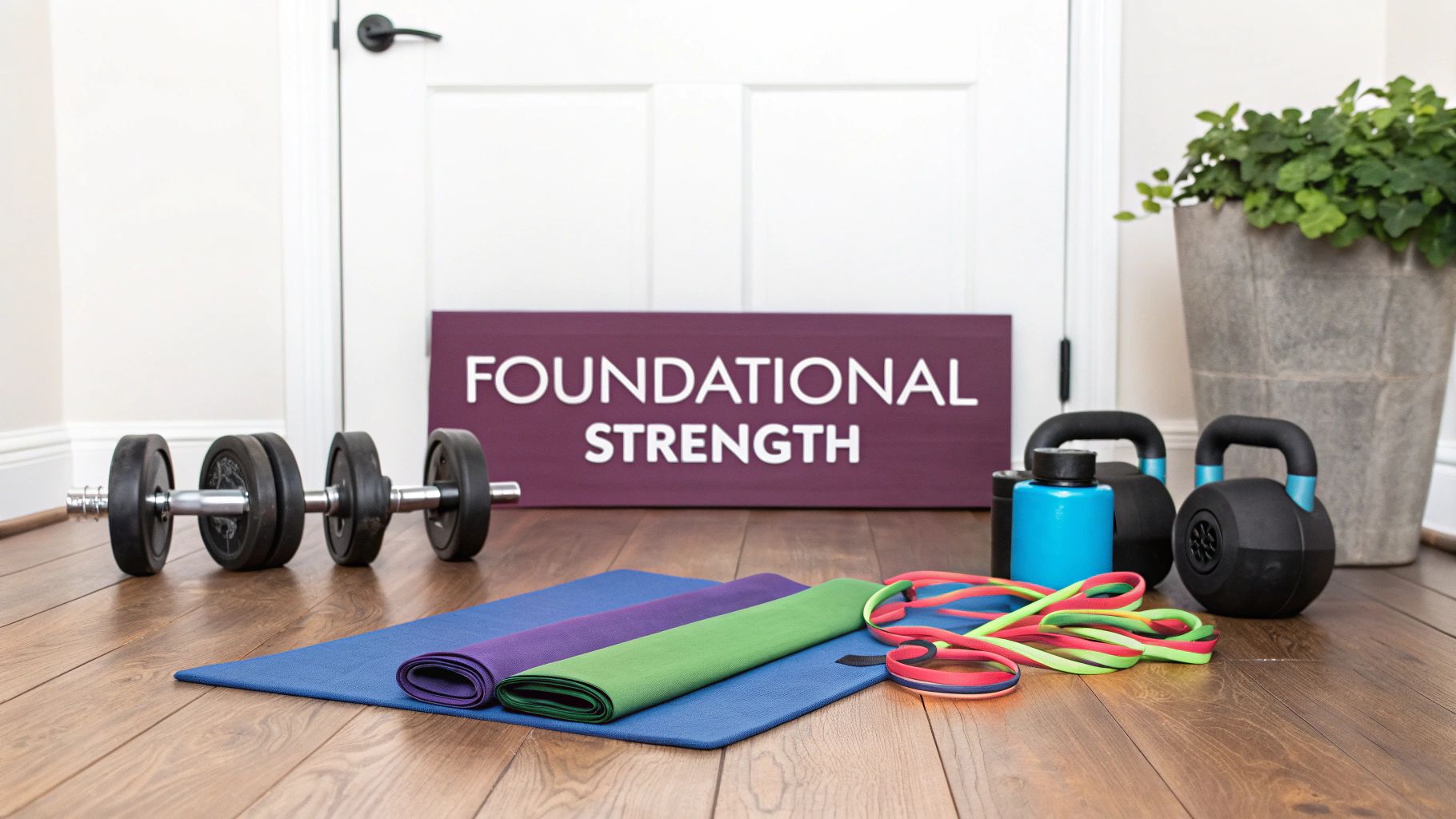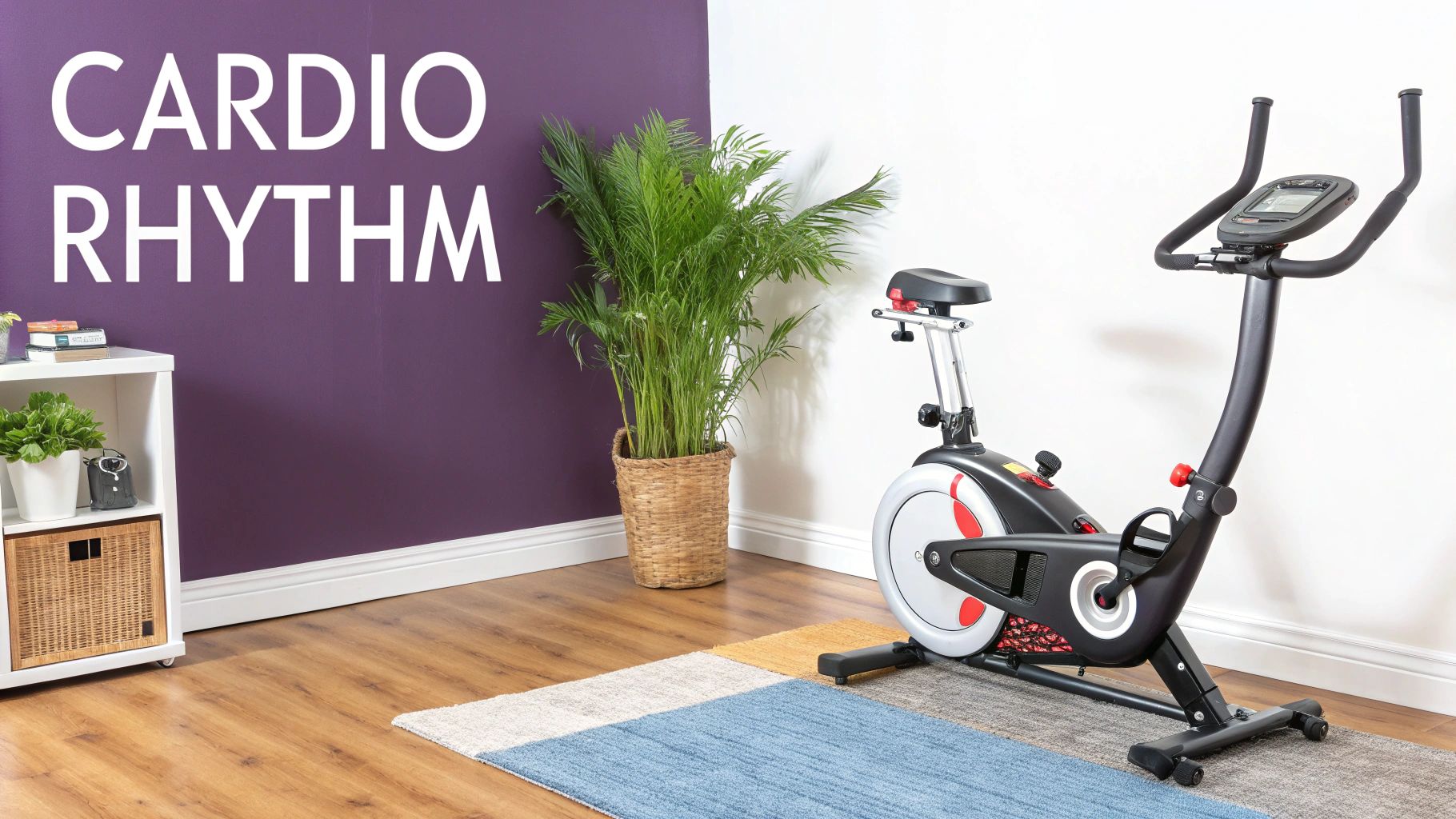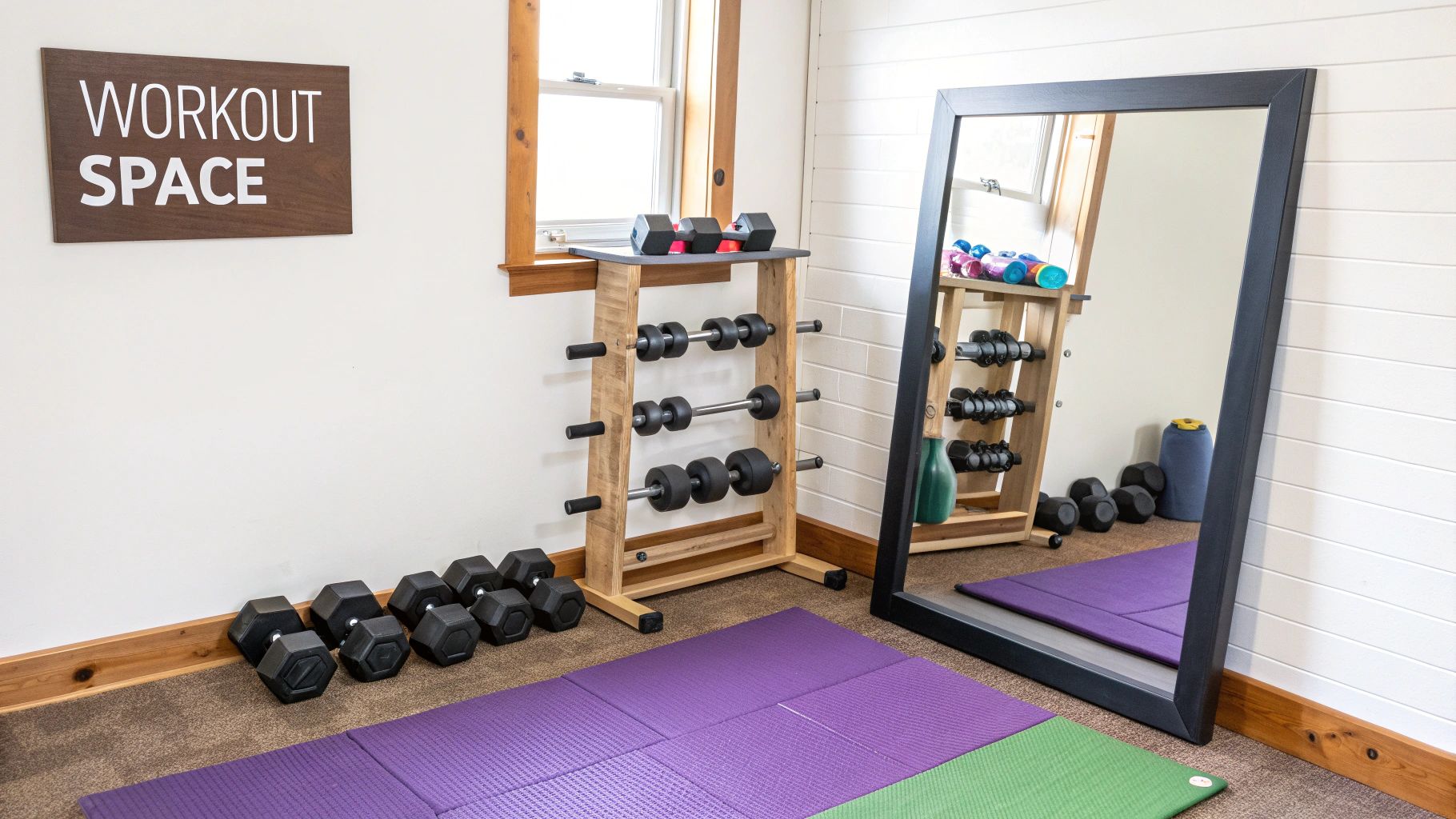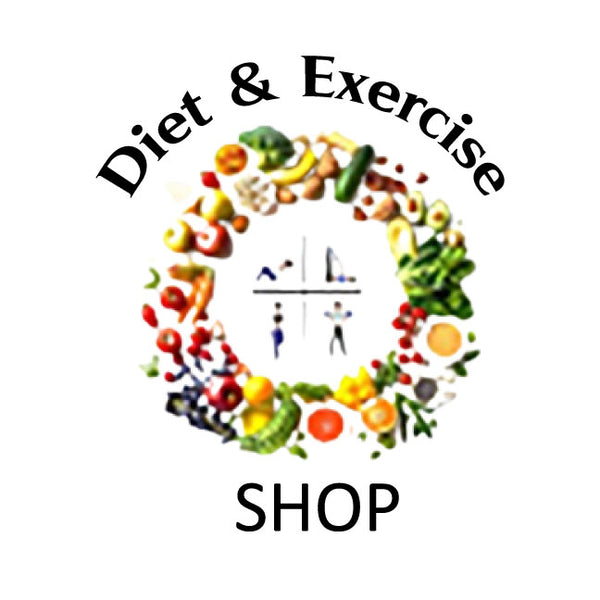
Best Home Gym Equipment for Beginners
For anyone just starting out, the best home gym equipment usually boils down to two things: a good set of adjustable dumbbells and some resistance bands.
These are the true MVPs of home fitness. They don't take up much space, they grow with you as you get stronger, and they won’t break the bank—the perfect starting point.
Starting Your Home Fitness Journey
Diving into home fitness can feel like a lot. You're bombarded with images of complicated machines and advice from every corner of the internet.
The key is to remember you’re not trying to build a commercial gym in your spare room. The real goal is to create a simple, motivating space with the right tools that actually work for you.
This guide is here to cut through the noise. We'll walk through how to pick gear that fits your goals, your space, and your budget. This infographic gives you a quick visual breakdown of the main equipment categories—strength, cardio, and flexibility—so you can see what they do and who they're for.
Think of it as a decision tree. Just match your main goal (building muscle, boosting heart health, or getting more flexible) to the right type of gear.

As you can see, what you want to achieve is the single most important factor in deciding where to put your money first.
Why Home Workouts Are Here to Stay
Working out at home isn't just a fleeting trend; it’s a fundamental shift in how people approach fitness. When gyms closed between 2019 and 2021, millions of people brought their fitness routines home, and that habit stuck.
During that time, the number of people identifying as beginners or occasional exercisers in major markets jumped from 32% to 42%. You can dig into more insights about the at-home fitness equipment market to see the full picture.
This boom has been great for consumers. It means manufacturers are now laser-focused on creating the best home gym equipment for beginners, with smarter designs, easy-to-follow tutorials, and more effective low-impact options than ever before.
Combining Diet and Exercise for Real Results
Buying equipment is just step one. If you want to see real, lasting change, your workout routine needs a partner: a solid nutrition plan.
Think of it like this—your workouts tell your body it's time to change, and your diet gives it the building blocks to actually do it.
For example, if you’re trying to build strength, lifting weights without enough protein is like trying to build a brick wall without any mortar.
And if weight loss is the goal, cardio is fantastic, but pairing it with a sensible calorie deficit is what really gets the job done. This powerful duo is the foundation for success.
To help you get started, here's a quick cheat sheet summarizing the best equipment options for beginners.
Beginner's Home Gym Equipment At a Glance
| Equipment Category | Primary Use | Average Beginner Cost | Best For Goals Like... |
|---|---|---|---|
| Dumbbells | Strength training, muscle building, toning | $50 - $300 | Building lean muscle, increasing overall strength |
| Resistance Bands | Strength, flexibility, and rehabilitation | $20 - $60 | Improving mobility, low-impact toning, warm-ups |
| Kettlebells | Full-body strength and cardio conditioning | $30 - $100 | Boosting power and endurance, high-intensity workouts |
| Yoga Mat | Floor exercises, yoga, stretching, core work | $20 - $50 | Enhancing flexibility, balance, and mind-body connection |
| Jump Rope | Cardiovascular conditioning, coordination | $10 - $30 | Improving heart health, burning calories, agility |
This table should give you a clearer idea of where you might want to begin your journey. Now, let's dive deeper into each category.
Building Foundational Strength
Strength training is the core work that builds lean muscle, keeps your metabolism humming, and strengthens your bones.
When you're just starting out, the goal isn't to lift the heaviest thing you can find. It's all about mastering the basic movements safely and consistently.
The right equipment really makes a difference here. As a beginner, you'll want tools that can grow with you. This means they can be adjusted or used in different ways as you get stronger, so your initial investment continues to pay off.
The Cornerstone: Adjustable Dumbbells
If we could only choose one piece of strength equipment, adjustable dumbbells would be at the top of the list.
Imagine an entire rack of weights—from 5 to 50 pounds—all packed into a single, neat pair. They save an incredible amount of space, which is a game-changer for most home gyms.
With a quick turn of a dial, you can switch from a light weight for bicep curls to a heavier one for squats.
This feature is critical for progressive overload, which is the secret to getting stronger. It means you gradually increase the challenge, forcing your muscles to adapt and grow. This versatility makes them a cornerstone of any functional home gym.
These Adjustable Dumbbells from dietexerciseshop.com are built to be easy to use and durable—a perfect match for beginners.
Low-Cost, High-Reward: Resistance Bands
Resistance bands are the unsung heroes of home fitness. They’re affordable, lightweight, and easy to store.
Don't let their simplicity fool you. Bands provide a unique kind of tension that challenges your muscles through the entire movement, which is something even free weights can't always do.
They're fantastic for beginners because they let you focus on getting your form right without the risk of heavy weights. This makes them ideal for learning the fundamentals like squats, glute bridges, and rows.
Bands are also amazing for waking up smaller stabilizer muscles, which is key for preventing injuries.
Perfecting Form with Foundational Exercises
You don't need a hundred different exercises to see results. Mastering just a few key movements will give you the most bang for your buck.
Proper form is non-negotiable. It ensures you’re working the right muscles and, more importantly, it keeps you safe.
Here are a few foundational moves you can do with dumbbells and bands:
- Dumbbell Goblet Squat: Hold one end of a dumbbell vertically against your chest. Keeping your back straight, lower your hips down and back like you're sitting in a chair.
- Bent-Over Dumbbell Row: Grab a dumbbell in each hand. Hinge forward at your hips, keeping your back flat, and pull the weights up toward your chest, squeezing your shoulder blades together.
- Banded Glute Bridge: Loop a resistance band around your thighs, just above your knees. Lie on your back with your knees bent. Drive your hips toward the ceiling, pushing your knees out against the band.
For more inspiration, check out our video on the Diet & Exercise YouTube channel for guided beginner workouts.
Fueling Your Strength Gains
Your workout is only part of the story. To build muscle, your body needs the right fuel to repair and grow.
Think of your muscles like a construction site: the workout breaks things down, and protein rebuilds everything bigger and stronger.
Try to get a quality source of protein in with every meal, especially after your workout. This could be chicken, fish, eggs, tofu, or a protein shake.
When you combine this simple eating habit with your strength routine, you create the magic formula for real results.
Finding Your Cardio Rhythm at Home
Cardiovascular exercise strengthens your heart, boosts your lung capacity, and helps you manage your weight.
The best piece of cardio equipment for a beginner is simply the one you'll actually use consistently.
The goal isn’t to push yourself to the breaking point. It’s about finding an activity you enjoy that gets your heart pumping. Focus on building a sustainable habit.

Choosing Your Cardio Machine
The home fitness market has exploded, with a greater focus on health and convenience.
Smart treadmills and connected bikes have made it incredibly simple for anyone to get started with interactive programs. You can discover more insights about this growing market and see how it's shaping exercise for newcomers.
Let's dig into the top choices for a beginner's home gym.
The Stationary Bike
A stationary bike is a classic choice for a good reason. It delivers a fantastic low-impact workout, which means it’s easy on your joints.
They're also incredibly quiet, so you can catch up on a show or listen to a podcast without blasting the volume.
- Space: Small footprint, and some models even fold up.
- Noise Level: Nearly silent. Great for apartments.
- Best For: Low-impact cardio and joint-friendly workouts.
The Treadmill
The treadmill taps into one of our most natural movements: walking. This makes it feel incredibly intuitive.
You can begin with a comfortable walk and slowly work your way up to jogging or running as your stamina builds. Many treadmills have pre-set programs that take the guesswork out of your workout.
- Space: Can be bulky, but many modern models fold up.
- Noise Level: Louder than a bike, especially when running.
- Best For: Walking, jogging, and interval training.
The Rowing Machine
A rowing machine delivers a powerful, full-body workout that hits your legs, core, and upper body all at once.
This makes it one of the most efficient calorie-burning machines out there. The movement is smooth and low-impact, but it takes a little practice to get the form right.
- Space: Long footprint, but most can be stored vertically.
- Noise Level: Varies by type (air rowers are loud, magnetic are quiet).
- Best For: Full-body conditioning and high-calorie burn.
Your First Week of Cardio
Getting started is easier than you might think. Consistency beats intensity every single time.
Here’s a simple schedule to ease into it:
- Monday: 20 minutes of steady-state cardio (e.g., walking at a conversational pace).
- Wednesday: 25 minutes of steady-state cardio.
- Friday: A 20-minute beginner interval workout.
Interval training alternates between higher effort and lower effort. It's an effective way to boost your fitness and burn more calories in less time.
Want to see what that looks like? This video from our Diet & Exercise YouTube channel breaks down a simple and effective interval workout that’s perfect for beginners.
Fueling Your Engine
What you eat has a huge impact on your cardio performance.
Think of complex carbohydrates as your body's premium fuel. Foods like oats, brown rice, and sweet potatoes release energy slowly, giving you sustained power. Aim for a small, carb-rich meal about 60-90 minutes before you start.
Don't forget about water! Hydration is critical. Sip water all day long, and be sure to have a glass before and after your workout.
The Power of Flexibility and Recovery
Flexibility and recovery are the unsung heroes of fitness. They are the crucial maintenance work that keeps you moving well and prevents injuries.
This is where simple, powerful tools come in. A good yoga mat is non-negotiable, and a humble foam roller can become your best friend for working out the kinks.
Building a great home gym is about creating a sustainable practice that takes care of you for the long haul.

Your Foundation: The Yoga Mat
A high-quality yoga mat is one of the most versatile pieces of gear you can buy. It's for stretching, core exercises like planks, and any movement on the floor.
A good mat gives you cushioning for your joints and a non-slip surface to keep you safe. For beginners, a slightly thicker mat can make floor work much more comfortable.
It's a small investment with a huge payoff. This High-Quality Exercise Mat is the perfect foundation for all your flexibility and core routines.
Demystifying The Foam Roller
That simple cylinder of foam is a game-changer for recovery. Foam rolling is a form of self-massage.
By rolling over tight, sore muscles, you help break up knots, reduce soreness, and boost blood flow to speed up the repair process.
Getting started is simple. For a visual guide on how to roll common trouble spots like your quads, hamstrings, and upper back, check out this fantastic video from the Diet & Exercise YouTube channel.
Fueling Your Recovery
What you eat after a workout is critical for helping your body repair, rebuild, and come back stronger.
Here's what your body craves after a tough session:
- Protein for Repair: Exercise breaks down muscle tissue. Protein provides the building blocks to patch things up and build new, stronger muscle.
- Anti-inflammatory Foods: Foods rich in antioxidants like berries and leafy greens help calm inflammation and ease muscle soreness.
- Hydration for Function: Rehydrating is essential for transporting nutrients to your cells and flushing out waste products.
When you pair smart recovery tools with mindful nutrition, you create a complete system that supports your fitness from every angle.
Designing Your Ideal Workout Space
You don’t need a massive room to build a home gym that gets real results. The best workout space is simply one you'll use consistently and safely.
The explosion in home fitness proves that convenience is king. The U.S. is the biggest market for home fitness gear, with over 50% of households owning equipment by 2023. You can see more data on these home fitness trends.
Laying The Groundwork
First, pick your spot. Look for a place with decent airflow and enough room to move safely.
Once you’ve claimed your territory, think about the floor. Interlocking rubber floor mats are a game-changer. They protect your floors from dropped weights, absorb impact, and visually define your workout zone.
Smart Storage for a Clutter-Free Zone
Nothing kills motivation faster than a messy workout space. Smart storage is critical to keeping your area tidy and safe.
Here are a few simple storage ideas:
- Wall Mounts: Hooks are perfect for hanging resistance bands, jump ropes, and yoga mats.
- Compact Racks: A simple, sturdy shelving unit can neatly organize kettlebells, foam rollers, and other odds and ends.
- Under-Furniture Storage: Low-profile bins on wheels can slide right under a bed or couch.
A well-organized space reduces mental friction. When your equipment is neat and ready to go, you eliminate one more excuse not to start your workout.
For more ideas on making the most of a compact area, check out our guide on the best home workout equipment for small spaces.
Creating an Energizing Atmosphere
Your workout space should be a place you want to be. A few small touches can transform a forgotten corner into a motivating personal gym.
Try incorporating some of these elements:
- Lighting: Bright, cool-toned light tends to be more energizing.
- Mirrors: A full-length mirror is an essential tool for checking your form and performing exercises safely.
- Sound: A small Bluetooth speaker lets you set the vibe with music.
Building Your Gym on a Budget
You don't need to spend a fortune to create an effective home gym. Start small with the basics and add new pieces as you go.
Here’s a realistic look at what you can build with different budgets:
Under $100: The Essentials
- High-Quality Yoga Mat: The foundation for any floor-based exercise.
- Resistance Band Set: Incredibly versatile for strength and mobility.
- Jump Rope: A cheap and effective cardio tool.
Under $300: The Strength Builder
- Everything from the "Under $100" setup.
- A Set of Adjustable Dumbbells: The single best investment for building strength at home.
$500+: The All-Rounder
- Everything from the previous tiers.
- An Adjustable Weight Bench: Unlocks dozens of new exercises.
- A Pull-Up Bar: The gold standard for upper body strength.
Your Questions Answered
Diving into home gyms can feel like a lot. Let's clear up some of the most common questions so you can move forward with confidence.

What Is the Single Best Piece of Equipment to Start With?
If we had to pick just one, it would be a set of adjustable dumbbells.
Their versatility is unmatched. They let you hit every muscle group, are compact, and can scale with you as you get stronger. They offer incredible value for any beginner.
How Much Should I Budget for a Starter Home Gym?
You can build an effective setup for under $150. This would include a good yoga mat, a versatile set of resistance bands, and a jump rope.
If you have a bit more to spend, a budget of $300-$500 will likely get you those game-changing adjustable dumbbells.
Remember, you don't need it all at once. Start with the basics and expand as you discover what you enjoy.
How Do I Stay Motivated to Work Out at Home?
The secret is to focus on building a routine and celebrating small wins. It's about consistency over intensity.
Here are a few practical tips:
- Schedule It: Put your workouts in your calendar like any other important appointment.
- Create a Space: Having a designated spot for exercise helps flip a mental switch.
- Follow a Plan: Taking the guesswork out is a game-changer. Follow a structured program or a video guide, like the ones on the Diet & Exercise YouTube channel.
Do I Need a Cardio Machine to Lose Weight?
No. A cardio machine is a helpful tool, but not a requirement for weight loss. The real foundation is a consistent calorie deficit from diet and exercise.
Strength training is a powerful piece of this puzzle. Building muscle increases your resting metabolism, meaning you burn more calories around the clock.
That said, a cardio machine can make it much easier to burn a significant number of calories consistently, which can speed up your progress.
At Diet & Exercise, we're all about making fitness simple and accessible. We've put together a collection of apparel and essential gear designed to support you from day one.
Find the perfect gear to kickstart your new routine at https://dietexerciseshop.com.
